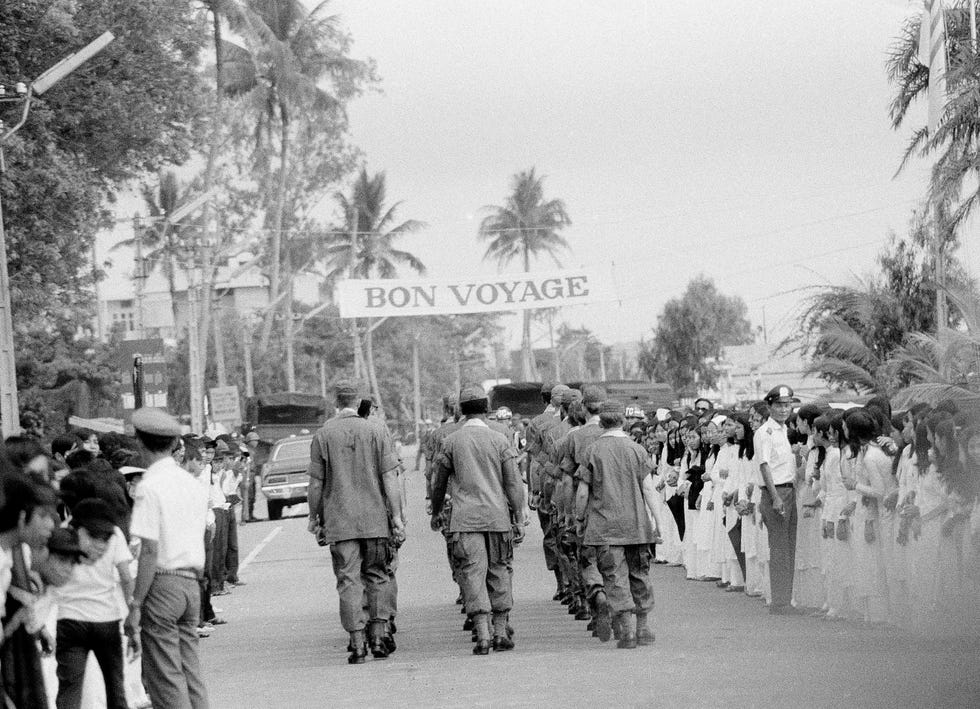[ad_1]
Wednesday marks the 50th anniversary of combat troops departing South Vietnam, the beginning of the end of the United States’ direct military involvement in the unpopular war.
Two months prior, representatives of the U.S North and South Vietnam, and the Vietcong signed a peace agreement, which included key provisions such as the withdrawal of U.S. troops, a cease-fire throughout Vietnam, the release of prisoners of war, and the peaceful reunification of North and South Vietnam, once new elections were held.
Military advisers to the South Vietnamese Army, Marines protecting U.S. installations and thousands of Defense Department civilians remained.
Despite the peace agreement, North Vietnam military officials violated the cease-fire and resumed a full-scale war by 1974. Saigon surrendered to communist forces on April 30, 1975 – one day after the iconic photo was taken of an American helicopter helping people escape off the roof of a CIA safe house.
The following year, South Vietnam was officially united as the Socialist Republic of Vietnam.
In total, nearly 60,000 Americans and 1.1 million North Vietnamese and Viet Cong fighters were killed in the war, which also claimed the lives of as many as 250,000 South Vietnamese soldiers and more than 2 million civilians.
‘The book from the enemy’:A lifetime after Vietnam, U.S. veteran delivers a diary to its home
How did the war begin?
After two decades of indirect military aid against the communist North, President John F. Kennedy sent the first large force of U.S. military personnel in 1961 in support of South Vietnam.
A pivotal moment in the 30-year struggle for control over Vietnam happened in 1965, when the first American combat troops entered Vietnam. At the same time, President Lyndon B. Johnson launched a three-year bombing campaign in North Vietnam. By 1967, President Johnson’s administration increased U.S. troops in Vietnam to 500,000, all while anti-war demonstrators began to protest in major cities nationwide.
Nixon’s gradual withdrawal
Republican Richard Nixon won the U.S. presidential election in November 1968 on the campaign promise to end the draft.
U.S. troops peaked at about 549,000 men in 1969. Domestic tensions continued to escalate, the most notable incident being the Kent State shooting in 1970, where U.S. National Guardsmen shot and killed four anti-war demonstrators and injured nine others in Ohio.
From 1969 until 1972, the Nixon administration gradually withdrew U.S. forces in South Vietnam, while simultaneously intensifying bombing and attempting to block enemy supply routes along Vietnam’s borders. President Nixon initiated a massive bombing campaign against North Vietnam in 1972.
On Jan. 27, 1973, the same day that the peace agreement was signed in Paris, The Selective Service announced the end to the draft. In the following few months, 591 American prisoners of war in North Vietnam returned to the U.S.
Later that year, Congress overrode Nixon’s veto to pass the War Powers Act, a law stating that the president is required to consult with Congress before committing U.S. forces abroad.
More coverage from USA TODAY
Camille Fine is a trending visual producer on USA TODAY’s NOW team.
What’s everyone talking about?Sign up for our trending newsletter to get the latest news of the day
[ad_2]
Source link

